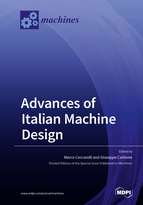Advances of Italian Machine Design
A special issue of Machines (ISSN 2075-1702).
Deadline for manuscript submissions: closed (31 May 2019) | Viewed by 54462
Special Issue Editors
Interests: mechanism design mechanics of robots; robot design
Special Issues, Collections and Topics in MDPI journals
Interests: robotics; robot design; mechatronics; walking hexapod; design procedure; mechanics of machinery; leg–wheel
Special Issues, Collections and Topics in MDPI journals
Special Issue Information
Dear Colleagues,
This Special Issue contains a selection of the best papers presented at IFIT 2018 on recent Italian advances on topics related to the theory, design, practice and application of the Mechanism and Machine Design. Novel results and solutions in the broad field of machines design, achieved in Italy as well as with international collaborations mainly within the IFToMM community, are presented.
Prof. Dr. Marco CeccarelliProf. Dr. Giuseppe Carbone
Guest Editors
Manuscript Submission Information
Manuscripts should be submitted online at www.mdpi.com by registering and logging in to this website. Once you are registered, click here to go to the submission form. Manuscripts can be submitted until the deadline. All submissions that pass pre-check are peer-reviewed. Accepted papers will be published continuously in the journal (as soon as accepted) and will be listed together on the special issue website. Research articles, review articles as well as short communications are invited. For planned papers, a title and short abstract (about 100 words) can be sent to the Editorial Office for announcement on this website.
Submitted manuscripts should not have been published previously, nor be under consideration for publication elsewhere (except conference proceedings papers). All manuscripts are thoroughly refereed through a single-blind peer-review process. A guide for authors and other relevant information for submission of manuscripts is available on the Instructions for Authors page. Machines is an international peer-reviewed open access monthly journal published by MDPI.
Please visit the Instructions for Authors page before submitting a manuscript. The Article Processing Charge (APC) for publication in this open access journal is 2400 CHF (Swiss Francs). Submitted papers should be well formatted and use good English. Authors may use MDPI's English editing service prior to publication or during author revisions.
Keywords
- Biomechanical Engineering
- Computational Kinematics
- Dynamics of Machinery
- Gearing and Transmissions
- History of Mechanism Science
- Industrial and Non-Industrial Applications
- Mechanism Design
- Mechatronics
- Multibody Dynamics
- Robotics
- Rotor Dynamics
- Tribology
- Vibrations







